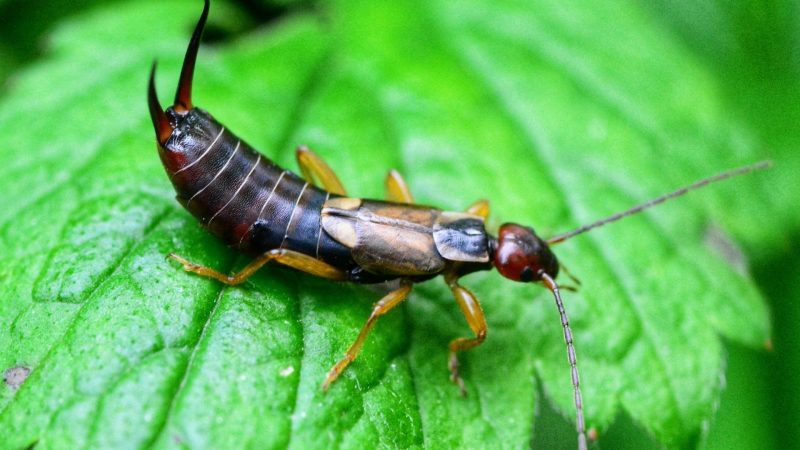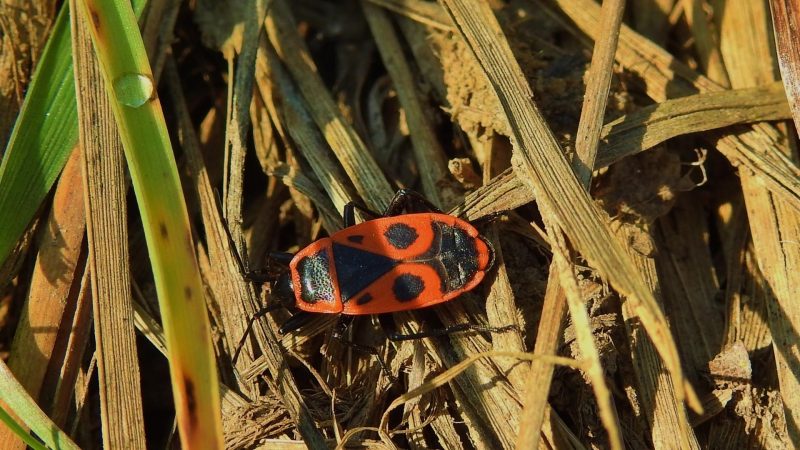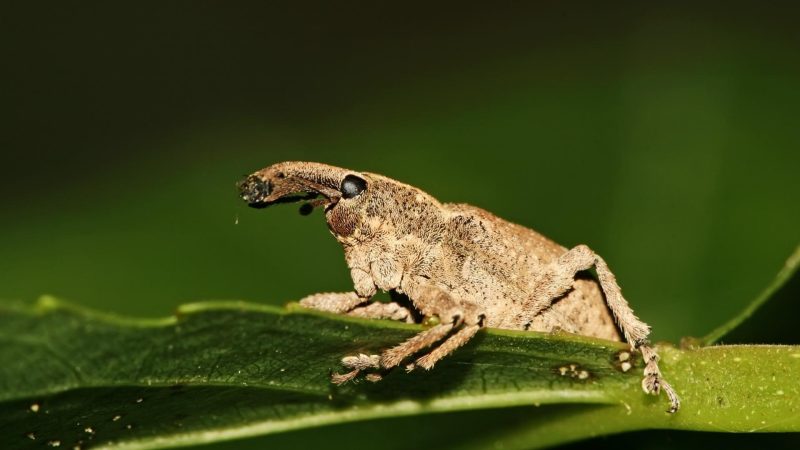Having a black bug inside your house can distract your daily activities. But don’t panic as most of them are harmless. However, there are lots of different kinds of bugs, and not all of them have round bodies.
Some of them are long and skinny. This is why you should know how to identify them before taking any action.
So, what could be the long skinny black bug in house? Among the bugs that can invade homes are earwigs, silverfish, firebrats, click beetles, and weevils. Although they have different habitats and characteristics, some of them are look-alikes and quite difficult to identify without the use of a magnifying glass.
To start with, discovering a long black bug in your house does not necessarily that it could lead to an infestation. It might be accidentally brought inside through purchased items.
But still, it’s better to investigate how it entered your home. Here is a complete guide about skinny black bugs and how to deal with them.
5 Long Skinny Black Bugs in House
Earwigs

Earwigs are insect pests in gardens but are also beneficial as being important predators of aphids. They are about 5/8 inches (16 mm) long, reddish-brown, with a flat, skinny body and very short wings.
These long bugs can easily be recognized because of their straight pinchers (cerci) at the end of their abdomen.
There are around 22 earwig species in the US, but the most common one is the European earwig.
Scientifically known as Forficula auricularia, this long skinny bug rarely flies and is active at night and hides during the day in dark, cool, moist places. Young earwigs look similar to adults but are smaller and lighter in color.
Earwigs usually feed on healthy and damaged, decaying plant matter, but they also eat dead and weakened organisms such as mites and insects.
In some cases, these nocturnal bugs will also attack soft fruits such as blackberries and strawberries but tend to ignore hard fruits such as apples, oranges, and lemons.
Are Earwigs Harmful to Humans?
Earwigs are not harmful to humans, and they don’t carry diseases. Contrary to popular myths, earwigs don’t sting or bite humans. However, they may pinch in self-defense using their strong but slender pinchers.
But despite their scary looks, earwigs cannot pinch hard enough to cause severe pain on the skin.
What Attracts Earwigs Inside My House?
Earwigs are attracted to light and are likely to invade homes only during extreme weather conditions. They can also be accidental invaders after hitchhiking in books, newspapers, boxes, and lumber brought into homes.
Nevertheless, large numbers may seek shelter, and earwigs can become notorious nuisance pests.
How to Get Rid of Earwigs Effectively?
Earwigs are not dangerous and don’t pose health risks to humans and pets. Their damage in plants is quite minimal, although they can be annoying pests indoors and can lead to an earwig infestation.
But because indoor insecticide treatment is not advisable, here are some natural ways to get rid of earwigs:
- Earwigs are short flyers, so you can easily vacuum or sweep them out of your house.
- Use traps with bait such as tuna fish oil, vegetable oil, or soy sauce. Traps can be small, low-sided cans, corrugated cardboard, or rolled-up newspapers.
- In your garden, remove debris such as piles of lumber, bricks, and leaves.
- To prevent entry, create a barrier around the foundation of your house using a residual insecticide product such as Ortho Home Defense Insect Killer .
Related: Earwig Control: How To Get Rid of Earwigs?
Silverfish and Firebrats
Silverfish and firebrats are two different insects. They look similar, and both belong to the order Thysanura. These look-alike household pests have carrot-shaped, flattened bodies covered with grayish scales.
They are also called bristletails due to their long appendages that are attached to the end of their abdomens.
Scientifically called Lepisma saccharina, the common silverfish can grow between 1/2 and 3/4 inches long. They are usually uniformly grey or silver, with short antennae.
On the other hand, firebrats (Thermobia domestica) are usually brown or mottled gray, about 1/2 inches long, and have longer antennae.
Silverfish and firebrats are both nocturnal insects, which means they are active at night and rest during daytime hours. Both of them feed on dry food such as pet food, pasta, cereals, flour, and dried meat.
Nevertheless, their favorite foods are paper sizing, books, wallpaper, paper with paste, and materials of plant origin.
Are Silverfish and Firebrats Harmful to Humans?
Silverfish and firebrats are harmless to humans. They don’t carry diseases and have very weak mouthparts, so they cannot bite.
Instead, these nuisance pests scrape the food little by little until they cause irregularly shaped holes. They attack damp, warm places, including bookshelves, storage areas, and kitchens.
Related: Do Silverfish Bite? | Information and Facts
What Attracts Silverfish and Firebrats Inside My House?
Silverfish and firebrats are very attracted to moisture and high levels of humidity, as well as polysaccharides (starch), which can be found in household glue, paper glue, and furniture.
In some cases, they are accidentally being brought home through books, paper, carton boxes, and furniture from infested sites.
How to Get Rid of Silverfish and Firebrats Effectively?
Bristletails are generally difficult to locate since they are very small, inactive during the day, and are very good in hiding.
Aside from that, this long skinny black bug can be almost anywhere, and it can live for up to three years. So to help you out, here are some effective ways to get rid of silverfish and firebrats:
- Trap them using glass jars covered with masking tape. Once bristletails climb and fall into them, they can no longer escape due to the slippery interior walls.
- Another effective trap is the BioCare Spider and Silverfish Sticky Trap , which is non-toxic and very easy to assemble.
- To discourage them from hiding in storage areas, reduce the humidity and use a dehumidifier such as Gocheer Upgraded Dehumidifier .
- Clean bookshelves, closets, and storage containers regularly, and store old books and papers in sealed plastic containers.
- If infestation is heavy, use odorless insecticide dust that contains synergized pyrethrin and pyrethroids or boric acid such as Dekko Silverfish Packs .
Related: How To Get Rid of Silverfish? | Top 11 Silverfish Repellents
Click Beetles

Click beetles (Elateridae) are a family of beetles that are known for their “clicking” ability to defend themselves from predators or when they are upset.
They also snap their bodies with a click sound to ‘right’ themselves once they get turned onto their back. The most common species is the eastern-eyed click beetle.
Scientifically called Alaus oculatus, the eastern-eyed click beetle is also called eyed elater because it has two black large spots on top of its thorax that look like huge eyes.
Their real eyes are much smaller, though. This long black bug can grow up between 1 and 1-½ inches long and has mottled gray wing covers.
Also called wireworms, click beetle larvae are cylindrical, hard-bodied, and have six tiny legs. Interestingly, they usually spend 3-4 years in the soil before they become adults.
They feed on a wide variety of crops including small grains, grasses, and vegetables such as carrots, corn, onions, peas, and potatoes.
Are Click Beetles Harmful to Humans?
Click beetles are not harmful to humans. They can bite humans if mishandled but are very rare. In most cases, they roll on their back when threatened.
This skinny bug does not carry diseases or sting. Adults may enter houses and can be nuisances, while their larvae can limit plant growth by feeding on roots.
What Attracts Click Beetles Inside My House?
Click beetles are very attracted to light, especially at night. Adults may also accidentally enter your home in search of shelter.
Fortunately, they don’t reproduce indoors and will leave on their own if they cannot find plant materials to eat. Wireworms, on the other hand, mostly stay outdoors rather than indoors.
How to Get Rid of Click Beetles Effectively?
Generally speaking, click beetles are not considered pests or beneficial. This is because some larvae species feed on the larvae of pest insects, while others don’t.
Adults indoors are considered accidental invaders, but huge numbers may be troublesome. If you want to get rid of them, here are some things you can do:
- Pesticides are not necessary indoors. Instead, find out how they are getting in.
- Sweep them out or use a vacuum cleaner and throw away the vacuum bag.
- Click beetles are nocturnal insects, which means they are most active at night. Turn off the lights before going to sleep.
- Repair holes and damage on windows screens and doors, as well as wall cracks.
- There are four kinds of traps for wireworms – pitfall trap, stocking trap, pot trap, and canister trap. According to a study, pitfall traps are the most effective.
Weevils

Weevils are small beetles that belong to the Curculionidae family and are known for having elongated snouts.
There are more than 60,000 weevil species globally, but the three most common ones are rice weevil (Sitophilus oryzae), maize weevil (Sitophilus zeamais), and granary weevil (Sitophilus granarius).
Rice and maize weevils have an average length of 3/32 inches (2.36 mm), with dull red-brown to black pear-shaped bodies and 4 light red to yellow spots on their back.
Granary weevils are about 2/10 inches (5 mm.) long and have a unique snout, which extends downward to about one-fourth of their body length.
Unlike rice and maize weevils, granary weevils cannot fly. In general, weevil larvae are legless and develop within the corn, wheat, and rice kernels. Both the adults and larvae feed on whole grain or seeds.
So, if you see some tiny, round holes in them, it is a clear sign of a weevil infestation, and you must take action.
Are Weevils Harmful to Humans?
Weevils are not harmful to humans, and they don’t bite or sting. They also don’t carry diseases or damage food products and properties.
However, they are destructive grain pests and can infest whole kernel grain foods in pantries. Unfortunately, it takes about a month before adults will emerge from the grains.
What Attracts Weevils Inside My House?
Adult weevils are very attracted to light and moisture. They will also look for shelter when the weather is too hot or too cold for them.
Weevils will enter your house by crawling through cracks or small openings in doors, windows, and around foundations. They may also be already present in your purchased grains.
How to Get Rid of Weevils Effectively?
Weevils are temporary nuisance pests only, which means that controlling them is not that hard. The only concern is that they have already created some damage in your stored grains and seeds before you realize their presence.
Here are some effective ways to get rid of weevils and prevent them from causing damage:
- If weevils are present in your grain storage area, vacuum them or sweep them out.
- Inspect grain and seed packs before buying them. Avoid buying pre-opened packs.
- Buy seeds and grains in small quantities or packs that can be consumed immediately.
- Inspect your stored grains thoroughly. If they have some tiny holes or dark spots, throw them away.
- Make sure your bins are emptied and cleaned properly before putting grains on them again. Avoid using pesticides in cleaning bins and storage containers.
- For grains with the suspected presence of weevils, place them in freezers for at least a week to kill possible eggs.
- Store food in tightly sealed plastic or metal containers, don’t use wooden storage compartments.
Related: How To Get Rid of Rice Weevils: A Complete Guide
Summary
Again, bugs come in different sizes, shapes, and colors. Different bug species may have different reasons why they are inside your house.
The key here is to properly identify them so you will know the best thing to do. This way, you can effectively get rid of them and prevent them from coming back.
List of Sources
Flint, M. L. (2012). Earwigs. University of California Agriculture & Natural Resources.
Rust, M. K., Millard, M. R. (2009). Silverfish and Firebrats. University of California Agriculture & Natural Resources.
Hurley, J., Porter, P. (2018). Click Beetle / Wireworm. Texas A&M AgriLife Extension.
Weevils on Stored Grain. (2017). PennState Extension.
- How to Get Rid of Turtles | Proven Long-Term Solutions! - August 26, 2023
- How to Get Rid of Kingsnakes | Easy & Humane! - August 26, 2023
- How to Get Rid of Northern Water Snakes | Best Solutions and Preventative Measures! - August 19, 2023
